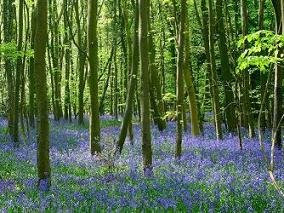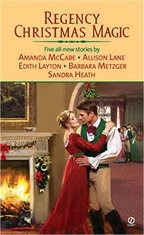One of our autumn rituals is to go apple-picking at a local orchard, coming home with bagfuls for eating and making pies. I use a recipe from my grandmother’s little old Lithuanian ladies’ group cookbook, with honey, raisins and nuts. Yum! I have to confess, though, I cheat and use the premade pie crust from the store. I used to try to make them from scratch and though they came out OK, the process involved a lot of cursing and sticking torn bits back together, and flour everywhere. Now everyone is happy. 🙂
 But while I’m steeped in autumn activities with the family, I’m also working on a section of a story that occurs in April. As a reader, I have no problem transitioning between seasons. If the author has done her job, I could enjoy a snowbound-in-a-cottage romance from a beach-chair. But as a writer, I find it takes some work to look away from the colors coming through my windows and picture springtime in England instead. It helps to look at images like this one, of a bluebell wood in England, like one I used to walk through when I lived there. For anyone who hasn’t smelled bluebells, the scent is similar to hyacinths. I know some people who think the fragrance is too strong but I love it. Walking through a wood like this and drinking in the purple-blue color and the scent is a heady experience!
But while I’m steeped in autumn activities with the family, I’m also working on a section of a story that occurs in April. As a reader, I have no problem transitioning between seasons. If the author has done her job, I could enjoy a snowbound-in-a-cottage romance from a beach-chair. But as a writer, I find it takes some work to look away from the colors coming through my windows and picture springtime in England instead. It helps to look at images like this one, of a bluebell wood in England, like one I used to walk through when I lived there. For anyone who hasn’t smelled bluebells, the scent is similar to hyacinths. I know some people who think the fragrance is too strong but I love it. Walking through a wood like this and drinking in the purple-blue color and the scent is a heady experience!
I also like to visit sites such as The British Library’s wildlife sounds archive to get an idea of the birdsongs of the season.


So for my fellow writers, do you have to do anything special to help you convey the sense of the season you are writing? For those of you like Amanda and Diane who write Christmas novellas, is this an issue for you? Personally, I’d find it hard to get into the holiday mood if it was 90 and humid outside. I don’t know what I’d do: turn up the AC and drap fake mistletoe around the writing room?
For our reader friends, is it ever a wrench for you to read a story set in a different season? Do you prefer certain sorts of books at certain seasons?
Elena
www.elenagreene.com

Right now is my very favorite time of year! I love the crisp, cool air, the changing leaves, the way the light looks in the evening. And Halloween! But I’m currently starting work on a book set at Christmas time, so am listening to lots of “Elizabethan Christmas” CDs. 🙂
I admit I love to read Christmas stories in November and December. So I save those stories up as and when I collect them throughout the year.
Other than that, the place, season, time, etc. doesn’t matter to me one whit, so long as the writer can take me there and immerse me into her story.
Ammanda, would you please give me examples of Elizabeth Xmas music? Thnx.
Elena, an aside… After our talk about favorite violinists, our local symphony sent me a special price booklet. These are the ones slated for spring 2009: Joshua Bell, Itzhak Perlman, Hilary Hahn, Midori, and Vadim Repin. Can you spell paradise?!?!?!?!!!!!
“Ammanda, would you please give me examples of Elizabeth Xmas music?”
The Baltimore Consort’s “Bright Day Star” is great (anything by them is great), and so is Lionheart’s “Tydings Trew”, Christopher Wilson’s “Elizabethan Lute Music” (not necessarily Christmas, but good!), “My Lady Rich” (music inspired by Penelope Rich), “Complete Lute Wors of John Dowland,” and Ronn McFarlane’s “The Renaissance Lute” are all good. Wow, I have more CDs of lute music than anyone should.
Plus the Chieftains’ Christmas album is very, very good. 🙂
And that is a VERY impressive symphony season!
Elena, what a great outing, picking apples and especially apple pie. I wouldn’t even attempt a pie without premade crust!
I loved writing A Twelfth Night Tale in Mistletoe Kisses. I had the great luck of having to write it during the Christmas season. It made both the writing and the Christmas season special for me.
Just have to brag about us! Or about Cara….
Her blog on Jane Austen’s Batman was picked up by the Jane Austen Centre’s online newsletter. The JA Centre in Bath!!! “It is really good,” they said.
Here a link
Elena, I’m with you on the pie crust! I used to make our family’s Thanksgiving pies with homemade crust (three to five pies, depending on how many were coming), and finally my mother insisted I use bought pie crust, because my stressing every time due to Pie Crust Issues was stressing out everyone else, too!
And thanks for the tip about the British Library’s wildlife sound archive — I never knew!
I do like reading holiday stories around the holidays, if possible…but otherwise, I think as a reader I don’t much care.
But as a writer, I sympathize! I have the most annoying habit of, in the heat of summer, being convinced that I will never again wish to wear long sleeves…and, if I’ve been somewhere cold for a while, absolutely knowing that one would never wish to wear less than a sweater over a long-sleeved shirt… 🙂
Cara
These are the ones slated for spring 2009: Joshua Bell, Itzhak Perlman, Hilary Hahn, Midori, and Vadim Repin. Can you spell paradise?!?!?!?!!!!!
Oh Keira, I am green with envy!
Amanda, one can never have anough lute music! Though my collection doesn’t rival yours, I like “The Renaissance Lute”, also “The Scottish Lute” also by McFarland.
Diane, I was thinking you were lucky to be able to write a Christmas novella during the Christmas season but then I started wondering how you found the time!
Cara, it’s comforting to know that someone else has Pie Crust Issues. At least there’s a cure. 🙂
Like Keira, I tend to save the Christmas set novels and novellas to read during the season. For the most part because Thanksgiving/Christmas are the BUSIEST times of the year at that bakery and also the most STRESSFUL!! It is nice to come home and curl up with some hot chocolate or Earl Gray and read a nice Christmas story. I generally pull all of my old favorites down every year to reread them.
Keira, I am SO JEALOUS! That is a fantastic season to look forward to! What a treat!
Thanks for the music list, Amanda. I have some of those, but not all and I am always looking for authentic period music.
And Cara, how impressive to have your genius recognized by the Jane Austen Centre! Kudos to you!
Cara, WOW!! That’s so cool?! And I’m honored we saw it here FIRST.
Ammanda, many many thanks for the recs. I have a pending, ahem, Amazon order. Think you add I that to?? 🙂
Ammanda, Elena, Louisa: Isn’t our symphony season just the most fabulous?
Thanks, Louisa & Keira! 🙂
Cara
I vote with Keira and Louise about preferring to read Christmas stories in November and December. And I really prefer to read them BEFORE Christmas. Dec. 24 is OK, but Dec. 26 is too late.
Also, I like to read Halloween stories in October. Again, Nov. 1 is a little too late for me.
Other than these quirks, any time the story is set is fine with me.
But if I really want to read the book, any time works.
If I get a holiday book in a different part of the year, sure I’ll read it. But the vast majority of the time, (since we’re focusing more on Christmas with this post) once October rolls around and the Christmas books come out, I do save them for December. 🙂 Love Christmas books!! 🙂
Lois
This is the time of year for an old-fashioned games of conkers! Check out my blog about this particular pasttime and other games children played during the Regency at http://www.joannawaugh.blogspot.com
Autumn’s the best.
Congrats Cara! Austen Batman was genius.
When I was a kid, there were some occasions I remember with my church in New York–picking apples, and making cider. In one way it is a very nostalgic memory for me. But on the other hand, I remember that I was bloody freezing the whole time!! 🙂
Autumn in the Los Angeles area is a little different. Everywhere you look, autumnal decorations in honor of Halloween and (later) Thanksgiving, and it’s 95 degrees outside. But no doubt it will cool off eventually…
My darling wife and I often spend part of the Christmas holidays reading Regency Christmas stories out loud. So I hope people go on writing them…
Todd-who-could-use-a-bit-of-seasoning